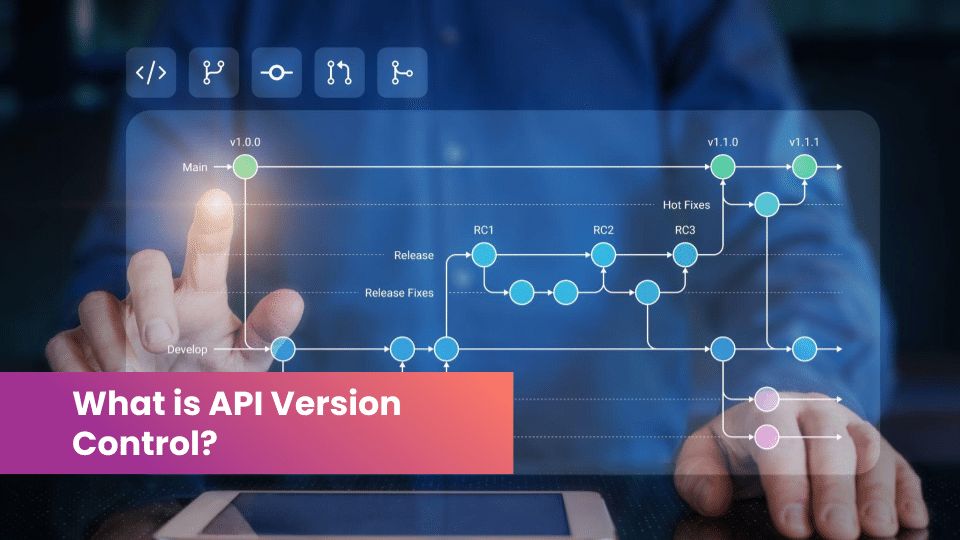APIs are the sets of rules and specifications that allow applications to share functionality and data. As APIs grow in complexity, so do the challenges of running them smoothly. Eventually, APIs need new parameters added, endpoints updated,
Changing APIs can adversely affect connected apps and cause problems for users. API versioning solves this by assigning a number to each version. This lets you tell users about changes clearly and gives them time to adapt. This way, in case something goes wrong, you can restore APIs to the last running version.
What Is API Versioning?
API Versioning management is the use of tools that track and manage changes in an API’s lifecycle. Versioning lets you create a system that communicates and applies updates clearly in a way that is archivable, and retrievable in case any issues arise.
Before dedicated API versioning tools, developers relied on a mix of manual processes and less structured approaches, like using dates or sequential numbers in file names or URLs to indicate different versions. However, this was inconsistent, relied heavily on developer vigilance, and was hard to manage.
API Versioning Best Practices
Like any software, APIs require updates, bug fixes, and new features to remain functional and secure. Even minor changes can cause unexpected issues for developers who depend on your API without clear versioning. Some API versioning best practices are:
- Changing Data: If your API modifies how it organizes data, such as combining first and last names into one field, versioning ensures compatibility with existing clients while allowing new structures to take effect.
- Security Updates: When implementing a new authentication method, like switching from basic authentication to OAuth or introducing multi-factor authentication, versioning provides developers with the tools and time needed to update their systems securely.
- Performance Boosts: Major improvements to your API’s performance, like reducing response times or optimizing processes, often affect how users interact with it. Versioning ensures these changes don’t disrupt current integrations.
- Legal Requirements: New laws and regulations related to data privacy and security require APIs to adapt. Versioning helps you meet compliance standards without interrupting users or risking their applications.
- Adding New Features: Introducing new features, whether minor enhancements or major additions, requires versioning to ensure that existing functionality remains stable for current users.
- Retiring Old Versions: When phasing out outdated parts of your API, versioning helps ensure a smooth transition. Clear timelines and instructions allow users to adapt their applications without unexpected disruptions.
- Working on Different Devices: To support various devices — desktops, smartphones, tablets, or IoT gadgets — versioning allows you to adapt the API for device-specific functionality and formats without breaking existing integrations.
- Data Model Overhauls: Significant changes to the underlying data structure, such as altering the schema or reorganizing the data model, demand versioning to preserve functionality while enabling modernization.
Benefits of API Versioning
Without API versioning, anytime a code change triggers an error, developers have to resort to lengthy audits of what went wrong and then come up with ways to fix it as users are experiencing issues. With versioning, it is easy to restore a functioning version while devs troubleshoot the update.
- Controlled Evolution: API versioning allows you to safely introduce changes to your API while ensuring existing users experience no disruptions. API versioning records how your API has evolved. This makes it easier to troubleshoot, track progress, and ensure that past decisions inform future changes.
- Less Disruption: Updates roll out in an organized way, so your customers don’t have to constantly adjust their code, creating a smoother experience for everyone involved.
- Clear Communication: Versioning informs your users by clearly outlining what’s changed, why it matters, and how it impacts their integration.
- Builds Trust: When developers see a stable, predictable API, they’re more likely to rely on it. Consistent versioning reassures them that their integrations won’t suddenly break.
- Handles Big Changes Carefully: Versioning allows you to implement major updates/changes without impacting users who rely on the existing functionality.
Types of API Versioning
API versioning is key for keeping APIs stable. It lets you make changes without breaking apps that use them. Some common API versioning techniques are:
- URL Versioning: This is the simplest and most widely used API versioning strategy. The version is included directly in the URL of the endpoint. For example: api.example.com/v1/
- Header Versioning: With this method, a specific header in the API request indicates the version to use. This strategy keeps versioning information out of the URL, resulting in cleaner and more readable endpoints.
- Query Parameter Versioning: The API version is passed as a query parameter in the request, allowing clients to specify the version without altering the URL structure. For example, api.example.com/users?version=
- Content Negotiation: In this method, the client uses the “Accept” header to request a specific API version with a particular format or data type. For example: Accept: application/vnd.api.v2+json
Boomi Makes API Versioning Simpler
APIs are essential for maintaining a strong software ecosystem, serving as the foundation for countless applications. API versioning ensures backward compatibility, manages variations, and allows you to roll out updates with a contingency to rollback.
Boomi simplifies API versioning with its API Lifecycle Management capabilities, which supports the complete API lifecycle across any environment. Here are the key benefits and features of the Boomi API Management:
- Federated API Control: Boomi discovers APIs across multiple gateways, providing a unified view, reducing redundancy, simplifying operations, and improving API consumption by making it easier for teams to locate and use APIs.
- Fortified Governance: The platform enforces consistent security and operational policies across all APIs with vendor-independent provisioning and flexible deployment options for cloud, on-premises, and private cloud.
- AI-Powered Productivity: AI agents accelerating APIM processes to reduce manual tasks and improve time-to-market for API releases. Developers and business users both benefit from agentic APIM improving productivity.
- Improved Security Features: The solution strengthens security by identifying shadow APIs and addressing vulnerabilities. Its advanced auditing tools and security policies protect your API ecosystem.
- Rich API Performance Insights: Boomi tracks API usage, response times, and adoption trends. These insights allow you to optimize performance and allocate resources efficiently.
- Customizable Branding Tools: Boomi enables you to customize your developer portal with branding tools. It also helps document, market, and promote APIs, ensuring they align with your organization’s identity.
- Scalable Flexibility: Power mission-critical applications with limitless scale. Manage billions of mission critical API transactions daily, ensuring global scale and superior reliability with zero overhead
Learn more about modernizing integration development as you go, by treating API Management as a Journey.


 English
English 日本語
日本語